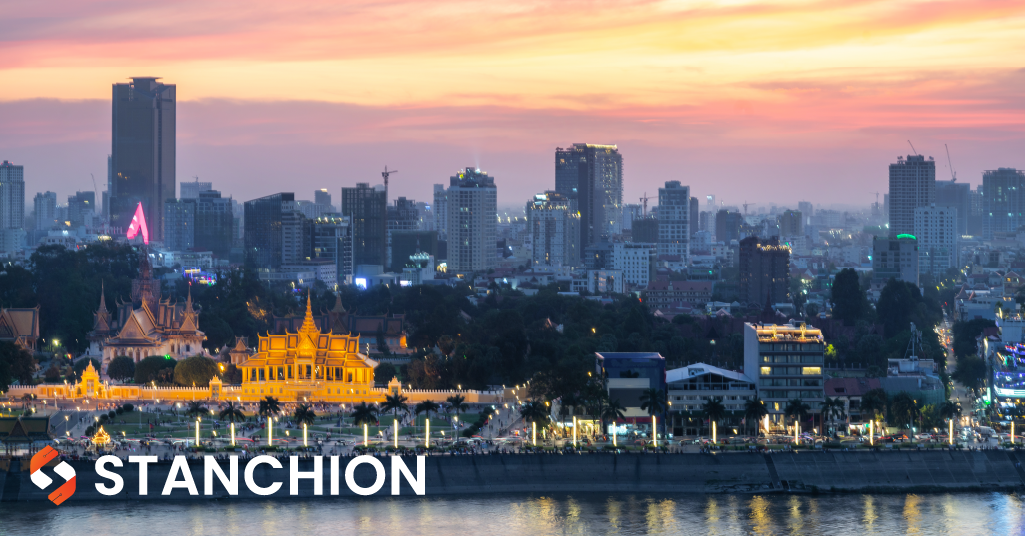
Author: Norman Frankel, Chief Growth Officer, Stanchion Payments Solutions
Last year, in 2024, Ethiopia was a market that surprised on the upside in every sense. Whilst still early in my travel schedule this year, Cambodia takes this title in 2025. Besides being a warm, helpful, friendly, safe country, it is surprisingly digital. One bank, ABA, has risen in recent years from circa 30th market share to one of the largest in the country but it’s also one of the top global examples of a bank with an excellent digital app.
It wasn’t long after leaving the airport that I noticed ATMs were housed in brightly lit, branded, glass telephone-like boxes. I haven’t seen this in other countries, and I was told it was to keep the area free from dust and rain.
Compared to the large markets I have just visited of Indonesia and Philippines, Cambodia is small at 17 million people, and a large percentage of them are people under 20, so is very much a young growth country, whilst its capital, Phnom Penh, has just 2.5m people. Despite this, Phnom Penh has a surprisingly large number of high-rise buildings, almost 2000 of them. In part, this is because during the communist Pol Pot years, people were driven out of the city into rural areas so the city, like digital banking, has leapfrogged.
Before delving in, I like flags and aside from Afghanistan, Cambodia’s flag is the only one in the world featuring a building. In this case, of the temple Angkor Wat, the largest religious building in the world covering some 400 acres (160 hectares) where Buddhism was practised.
Stanchion has been blessed to have the aegis of the Australian Trade and Investment Commission (Austrade), the commercial development agency of the Australian Government. In Cambodia, I had the support of Phala Bun, who speaks the local language fluently. He was instrumental in helping to set up a potential local partner for us, which is a key requirement in the region to successfully develop your business. It has been impressive what Cambodia has achieved in its digital innovation, and they openly welcome international visitors as they are keen to gain fresh perspectives.
The article below aims to give the reader a sense of what is happening in Phnom Penh, the capital city, and Cambodia in terms of both economic development and also the local payments industry. To learn more please read on.
Phnom Penh: From Colonial Outpost to Modern Metropolis
Phnom Penh, Cambodia’s capital, has undergone a dramatic transformation from its colonial roots to a bustling urban centre. The country has a rich heritage and at different times has been ruled by both the French and Japanese. The city’s rapid modernisation is evident in its skyline. The year 2024 alone saw the construction of nearly 1,900 high-rise buildings and over 450 housing complexes. With a population growth rate of about 3% annually, projections suggest that Phnom Penh could reach 6 million residents in the next decade.
This urban surge is rightly matched by a tourism boom: in 2024, the city welcomed over 11 million visitors, a 63% jump from the previous year, signalling Phnom Penh’s emergence as a key destination for both domestic and international travellers, although the country still struggles to gain the tourism numbers that Thailand and Vietnam achieve.
The local government is prioritising infrastructure, public services and cultural appeal, aiming to position Phnom Penh alongside leading ASEAN capitals. A new enlarged international airport will open in July this year.
The waterside river walk from the Royal Palace is a 2km stretch that takes in both old and new buildings alike. In the evening, it’s a popular place to walk and offers spectacular views of the boats that ply the river tributary which runs out to the Mekong. This tributary is one of the rare rivers in the world that changes its directional flow during the year.
Cambodia’s Economic Growth Plans: Diversification and Digital Ambitions
Cambodia’s economy has robust growth. The IMF forecast a 5.8% GDP increase in 2025, supported by the expanding sectors of electronics, automotive parts and food processing. Large-scale investments in highways, airports and ports, with a resurgent tourism industry, help fuel this momentum. The government’s focus on diversification and a green transition is central to its strategy, with the industrial sector expected to grow by 8.6% in 2025, particularly in garment and electronics manufacturing.
Cambodia has a huge SME / MSME sector. Over 98% of the economy is driven by these small merchants so the government has been keen to include solutions that benefit them. The national QR scheme achieves this.
The government has a few other priorities. Education appears to be one as I witnessed many international schools from many different countries. The government is keen to drive tourism and whilst only having had a brief glimpse of the city, I can highly recommend a visit. Digitalisation is the other key strategy.
The digital economy is rising rapidly, with fintech and e-commerce still to play increasingly significant roles. Currently, eCommerce is nascent and is yet to take off, whilst the fintech scene has started but predominantly appears to be local in nature. The country is embracing cloud services. The government’s vision, set out in the “Cambodia 2040” report, includes boosting technology access, implementing digital IDs and fostering regulatory frameworks that support digital payments and financial inclusion.
The Retail Payments Industry: All about Digitalisation
Cambodia’s retail payments landscape has and is evolving quickly, driven by the National Bank of Cambodia (NBC). The NBC has a less onerous regulatory approach within the ASEAN region on the one hand, which has allowed it to spearhead key initiatives such as the KHQR code standard and the Cambodian Shared Switch (CSS), both of which have made cashless transactions more accessible and secure. The KHQR system enables QR code payments across banks using real-time rails and settlement, while CSS allows seamless debit card transactions at ATMs and POS terminals nationwide.
The NBC has been pivotal in Cambodia’s payment transformation, enacting policies that encourage cashless transactions and financial inclusion. Its Bakong system, a blockchain-based digital payments platform, now boasts 27.6 million accounts and is accepted by 3 million merchants, marking a significant shift in consumer behaviour and transaction efficiency. The NBC is also enabling cross-border payments interoperability with neighbouring countries, further integrating Cambodia into the regional digital economy. One example of a local innovation off the back of the successful QR initiative is the new Bakong Tourist App. This allows international visitors to add their cards then link to it in order to use the KHQR national system. I haven’t seen this level of QR innovation anywhere else on the Asia road trip, and it is a great example of
twinning the tourist, MSME and digital payment initiatives. The project is still in its infancy, and I did have issues doing account verification, but these will get resolved.
However, these QR-driven initiatives are ones that benefit the government and NBC, because Cambodia is also the only market I have come across where the regulator then requires each bank to get further regulatory approval prior to launching any new product. A good example of this is Google Wallet, which achieved its regulatory approval to launch in the market about a year ago. However, not a single bank has gone live as yet as banks are still waiting for the regulator to approve the specific project. This seems a very cumbersome approach and it’s a shame that this approach has been taken as Cambodia could have been even further ahead in its digital ambitions.
Serving a relatively small population are 60 banks. Most of them find their roots in microfinance and with strong agency banking models. Like most countries, the largest market share is held among a small select group leaving the rest with low volumes which makes them highly cost conscious when seeking vendors. It also means these banks lack key skills and experience to help them compete.
Digital wallets are booming, with 19.7 million e-wallet accounts recorded, reflecting widespread trust in digital payments.
Card Issuing and Usage
The number of payments cards in circulation has grown steadily, with both debit and credit card markets expanding. Visa is the largest scheme by some way in the market with probably about a 70% market share and Visa card usage is surging; payment volume of Visa cards issued in Cambodia rose 22% year-on-year in Q4 2023, and contactless transactions increased by 16% in December 2023.
Banks and fintech’s are increasingly offering digital and virtual cards, which is much easier to do given the advanced nature of the digital banking apps prevalent in the market. For example, Wing Cambodia, in partnership with Visa, launched a digital prepaid card linked to users’ mobile wallets, allowing instant issuance and top-up.
Some banks are launching cloud-based banking as a service capability with MBanq being an example of one vendor that is supporting banks to launch digital banks alongside its traditional bank.
Cambodia is well on its way to having a cashless future at least in urban areas. The key pillars are in place for achieving this transition, which include expanding Internet and mobile access, introducing digital IDs and creating supportive regulatory environments. Government policies aimed at digitising public financial management and incentivising SMEs to adopt digital payments are critical and it’s all part of what is being worked on. The continued growth of digital payment acceptance among merchants and consumers, combined with innovative solutions like tokenisation and virtual cards, will help to position Cambodia as a digital payments’ leader in Southeast Asia.
Powering Cambodia’s Payments Evolution with Stanchion
Cambodia’s payments ecosystem has already gained high adoption of digital bank apps, self-service controls in-app and has regulated for Google Wallet to be in market so the country now stands at a pivotal moment.
The next frontier is for the regulator to relax the need to introduce a double gate system on product innovation. If this is done, then the market will move rapidly to a next phase, and this could see a surge of fintech ideas coming in from outside the country. The next step will be tokenisation, token life-cycle management and digital card issuing, including one-time card issuance to help with the growth of eCommerce. Whilst the largest banks are ready, another 50+ banks need to gain this capability to be truly inclusive for society.
This is where Stanchion’s Payment Fabric can provide mid-size Cambodian banks with a key advantage. Our modular and adaptive technology bridges the gap between legacy banking infrastructure and next-generation digital payment experiences. By enabling seamless integration across banking platforms, card networks and digital wallets, we empower financial institutions to innovate at speed, optimise costs and deliver the frictionless digital experiences that modern consumers expect.
To remain competitive, banks must invest in robust digital infrastructure, forge strategic partnerships and prioritise customer-centric solutions that match and augment the convenience of the KHQR programme. With a global footprint and deep APAC/Oceania market expertise, Stanchion is uniquely positioned to support this transition — helping banks build scalable, future-ready payment ecosystems that align with Cambodia’s dynamic, mobile-first economy.
Stanchion is ready to collaborate and shape the future of payments with Cambodian Banks and Fintechs. Over the next few months, we will seek to engage with and train an identified local partner and hold discussions with banks to explore whether they have the appetite to drive the next phase of digital payment change locally.


 Verto
Verto Switchcare
Switchcare Professional Services
Professional Services

